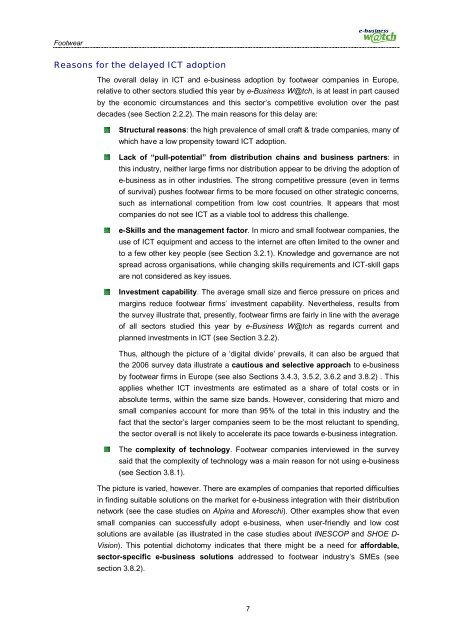Footwear Industry Footwear Industry - empirica
Footwear Industry Footwear Industry - empirica
Footwear Industry Footwear Industry - empirica
You also want an ePaper? Increase the reach of your titles
YUMPU automatically turns print PDFs into web optimized ePapers that Google loves.
<strong>Footwear</strong><br />
Reasons for the delayed ICT adoption<br />
The overall delay in ICT and e-business adoption by footwear companies in Europe,<br />
relative to other sectors studied this year by e-Business W@tch, is at least in part caused<br />
by the economic circumstances and this sector’s competitive evolution over the past<br />
decades (see Section 2.2.2). The main reasons for this delay are:<br />
Structural reasons: the high prevalence of small craft & trade companies, many of<br />
which have a low propensity toward ICT adoption.<br />
Lack of “pull-potential” from distribution chains and business partners: in<br />
this industry, neither large firms nor distribution appear to be driving the adoption of<br />
e-business as in other industries. The strong competitive pressure (even in terms<br />
of survival) pushes footwear firms to be more focused on other strategic concerns,<br />
such as international competition from low cost countries. It appears that most<br />
companies do not see ICT as a viable tool to address this challenge.<br />
e-Skills and the management factor. In micro and small footwear companies, the<br />
use of ICT equipment and access to the internet are often limited to the owner and<br />
to a few other key people (see Section 3.2.1). Knowledge and governance are not<br />
spread across organisations, while changing skills requirements and ICT-skill gaps<br />
are not considered as key issues.<br />
Investment capability. The average small size and fierce pressure on prices and<br />
margins reduce footwear firms’ investment capability. Nevertheless, results from<br />
the survey illustrate that, presently, footwear firms are fairly in line with the average<br />
of all sectors studied this year by e-Business W@tch as regards current and<br />
planned investments in ICT (see Section 3.2.2).<br />
Thus, although the picture of a ‘digital divide’ prevails, it can also be argued that<br />
the 2006 survey data illustrate a cautious and selective approach to e-business<br />
by footwear firms in Europe (see also Sections 3.4.3, 3.5.2, 3.6.2 and 3.8.2) . This<br />
applies whether ICT investments are estimated as a share of total costs or in<br />
absolute terms, within the same size bands. However, considering that micro and<br />
small companies account for more than 95% of the total in this industry and the<br />
fact that the sector’s larger companies seem to be the most reluctant to spending,<br />
the sector overall is not likely to accelerate its pace towards e-business integration.<br />
The complexity of technology. <strong>Footwear</strong> companies interviewed in the survey<br />
said that the complexity of technology was a main reason for not using e-business<br />
(see Section 3.8.1).<br />
The picture is varied, however. There are examples of companies that reported difficulties<br />
in finding suitable solutions on the market for e-business integration with their distribution<br />
network (see the case studies on Alpina and Moreschi). Other examples show that even<br />
small companies can successfully adopt e-business, when user-friendly and low cost<br />
solutions are available (as illustrated in the case studies about INESCOP and SHOE D-<br />
Vision). This potential dichotomy indicates that there might be a need for affordable,<br />
sector-specific e-business solutions addressed to footwear industry’s SMEs (see<br />
section 3.8.2).<br />
7

















